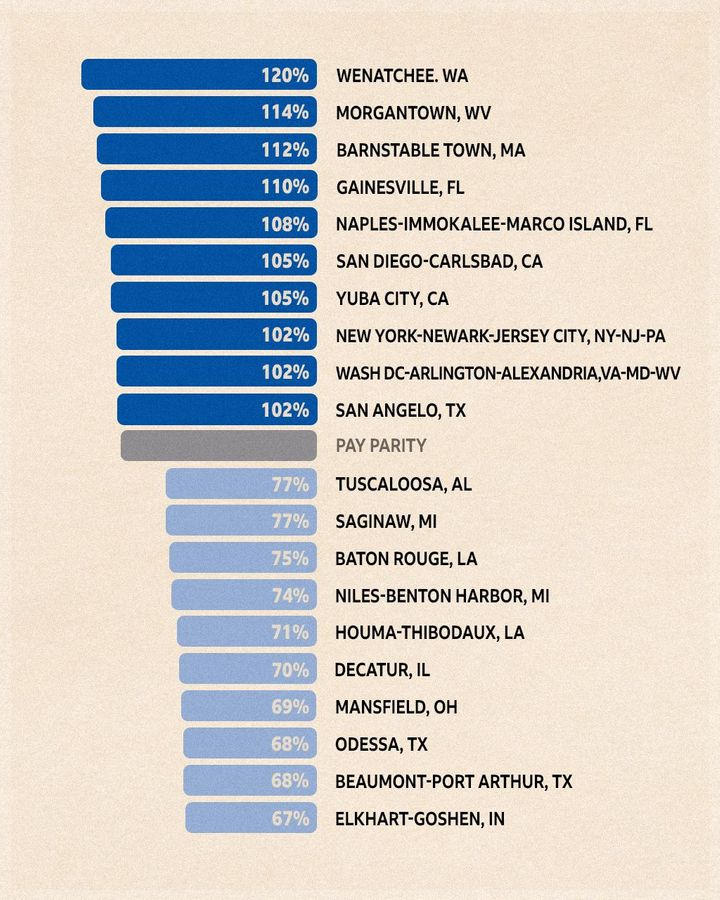
(Image credit: Getty Images)
West Virginia is a US state commonly cited for its coal mines and country roads – not for its place in the pay-gap conversation. But according to a new Pew Research Center analysis of US Census data, the metropolitan area of Morgantown – the state’s third largest city, home to West Virginia University – is one of only a few places in the nation where women out-earn their male counterparts.
In this area, the median salary of full-time female workers younger than 30 is 14% more than the median salary of men in the same group. In fact, the Appalachian city is second – just behind Wenatchee, in the state of Washington – on a top-10 list of metro areas where women younger than 30 come out on top comparatively.
Nationally, the gender wage gap persists; on average, US women earn 82 cents for every dollar their male peers are paid. But in 22 of the 250 metros examined in the analysis, women’s salaries are on par or better. Why do women out-earn men in highly specific areas of the US – and do promising figures in certain areas mean the wage gap could be slowly closing?
Education and industry
There are some patterns that help explain these findings, says Richard Fry, senior researcher with Pew, who authored the report.
First, education is a factor. The places where women have parity or out-earn men – mostly cities along the country’s east and west coasts – have a higher percentage of young women with degrees, explains Fry. “In metros where young women have a bigger advantage educationally, the pay gap tends to be smaller,” he says. “Completion of bachelor’s degrees tends to boost earnings, and the pay gap tends to narrow down.”

The US cities where women younger than 30 are earning both the most and least, compared to their male counterparts (FT median annual earnings) (Illustration: Javier Hirschfeld)
This component may at least partially explain why some specific cities in Florida and West Virginia make the top-10 list, despite their respective statewide average wage gaps of 15% and 26%. “Morgantown is a university town,” says Fry, “and so is Gainesville, Florida … among the 22 metros where there’s either parity or better, many are home to large universities.”
Those towns may have an outsize number of higher-paying jobs on offer. Plus, women who stick around in these metro areas after graduation stand to be paid better, thanks to the “educational advantage”, says Fry.
Education is also likely at least partially what propels Wenatchee, Washington to the very top of the list. The median annual salary of women there is 120% that of young men. “In Washington, 60% of women, I believe, have a bachelor’s degree,” says Fry. “So, you’re talking about a really well-educated young women’s workforce in Washington.”
Another factor influencing the wage gap is the type of jobs and industries that dominate certain geographic areas. The second-largest employer in Wenatchee is the metro’s school district; in the US, women fill more than three-quarters of education jobs. Women’s share of manufacturing jobs, on the other hand, is below 30%. In a number of metro areas where the wage gap is largest – including Saginaw, Michigan; Decatur, Illinois; and Mansfield, Ohio – manufacturers are among the top employers.
“In metros where young women have a bigger advantage educationally, the pay gap tends to be smaller”
“The metro with the greatest pay disparity is Elkhart-Goshen, Indiana, where young women only earned 67% of their male peers,” says Fry. “That’s kind of known as the ‘RV [motorhome] capital of the world’.” In fact, more than 80% of global RV production happens in that region of northern Indiana, near the Michigan border. “There’s a lot of manufacturing going on, and that can have consequences for how well young women do compared to young men.”
The motherhood factor
When – or if – women choose to have children can play into a geographic area’s wage gap. Throughout the country – and across the globe, in countries including the UK – women suffer from a ‘motherhood penalty’ that widens the wage gap; once women become mothers, they earn even less relative to men (meanwhile, men see their earnings go up when they become parents). By some estimates, mothers make only 70 cents for every dollar fathers do.
This article was written by By Kate Morgan on 19th April 2022. To read the full article please click here.

